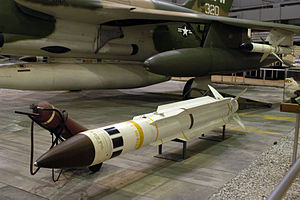avia.wikisort.org - Weapon
The AGM-78 Standard ARM was an anti-radiation missile developed by General Dynamics, United States. It was built on the airframe of the RIM-66 Standard surface-to-air missile, resulting in a very large weapon with considerable range, allowing it to attack targets as much as 50 miles (80 km) away.
| AGM-78 Standard ARM | |
|---|---|
 | |
| Type | Air-to-surface anti-radiation missile |
| Place of origin | United States |
| Service history | |
| In service | 1968–1988 |
| Wars | Vietnam War |
| Production history | |
| Designed | 1967 |
| Produced | 1967–1976 |
| No. built | 3,000+ |
| Specifications | |
| Mass | 620 kg (1370 lb) |
| Length | 4.57 m (15 ft) |
| Diameter | 34.3 cm (13.5 in) |
| Warhead weight | 97 kg (215 lb) blast-fragmentation |
| Engine | Aerojet MK 27 MOD 4 dual-thrust solid-fueled rocket |
| Wingspan | 108 cm (42.5 in) |
Operational range | 90 km (56 mi) |
| Maximum speed | Mach 1.8 |
Guidance system | Passive radar homing |
Launch platform | A-6B/E Intruder, F-105G Thunderchief, F-4G Phantom II |
Overview
Originally developed for the US Navy during the late 1960s, the AGM-78 was created in large part because of the limitations of the AGM-45 Shrike, which suffered from a small warhead, limited range and a poor guidance system. General Dynamics was asked to create an air-launched ARM by modifying the RIM-66 SM-1 surface-to-air missile. This use of an "off the shelf" design greatly reduced development costs, and trials of the new weapon began in 1967 after only a year of development. The first operational missiles were issued in early 1968.
The AGM-78 was nicknamed the "Starm", an abbreviation of Standard ARM.[citation needed] The first version of the missile, the A1 Mod 0, was little more than an air-launched RIM-66 with the Shrike's anti radar seeker head attached to the front. An Aerojet Mark 27 MOD 4 dual-thrust solid-rocket-powered the missile, which was fitted with a blast-fragmentation warhead. Although more capable, the AGM-78 was much more expensive than the AGM-45 Shrike which continued in service for some time. The new missile was carried by the F-105F/G and the A-6B/E.
Variants


An inert training version of the AGM-78A was built as ATM-78A. Of equal size, mass and shape, the missile lacked a seeker head, warhead, or propulsion systems and was essentially just a dead weight.
An A2 model introduced a bomb damage assessment (BDA) capability and an SDU-6/B phosphorus target marker flare to facilitate targeting of the site for follow up attacks.
In 1969 an improved model called the AGM-78B was produced. This featured a broadband seeker which allowed the missile to be used against a much wider variety of targets without having to select the seeker before the mission. A simple memory circuit was also included, allowing the missile to attack a target once it locked on, even if the radar was shut down. Previous ARMs would veer off course and miss when they lost a target, and as a result flipping the radar on and off had become a standard tactic for missile batteries.
Some early AGM-78A1s were updated with the new memory circuit and seeker. These missiles were designated as the AGM-78A4. The AGM-78B was the most important version of the missile, and was widely used by the Air Force's F-4G Phantom II Wild Weasel aircraft.
A training version of the AGM-78B was created, and was known as the ATM-78B.
In the early 1970s the AGM-78C was produced. A US Air Force project, the C model was primarily intended to be more reliable and cheaper to build. It had a SDU-29/B white phosphorus target marker. Some older missiles were upgraded to the AGM-78C standard. As before, an ATM-78C training missile was produced.
Between 1973 and 1976 the AGM-78D was produced, introducing a new motor. A follow up missile, the AGM-78D2, had an active optical fuze, still greater reliability, and a new 100 kg (220 lb) blast-fragmentation warhead. The ATM-78D training missile followed.
The RGM-66D shipborne anti-radiation missile used the basic AGM-78 airframe along with features of the RIM-66 and AIM-97 Seekbat air-to-air missile.
Including all versions, over 3,000 AGM-78 missiles were built. Production stopped in the late 1970s, but the missile continued in service for almost a decade before the last examples were replaced by the AGM-88 HARM in the late 1980s.
Operators
 United States
United States Israel
Israel
External links
На других языках
[de] AGM-78 Standard ARM
Die US Navy stellte 1968 die von General Dynamics entwickelte AGM-78 Standard ARM als Anti-Radar-Luft-Boden-Rakete in Dienst. Die AGM-78 wurde als Erweiterung für die AGM-45 Shrike aus der RIM-66 entwickelt. Die erste Version der Standard ARM in der Navy, dort auch STARM genannt, war nichts weiter als die Luft-Boden-Variante der RIM-66, die nur mit einem Anti-Radar-Suchkopf ausgestattet wurde. Die AGM-78 hatte jedoch einen Nachteil – sie war wesentlich teurer als die Shrike.- [en] AGM-78 Standard ARM
[fr] AGM-78 Standard ARM
L'AGM-78 Standard ARM était un missile anti-radar développé par la firme General Dynamics, aux États-Unis. Conçu en 1967 et produit depuis cette date, il en sera fabriqué plus de 3 000 jusqu'à l'année 1976, date de l'arrêt de sa production.[it] AGM-78 Standard ARM
L'AGM-78 Standard ARM è un missile antiradar. Era la versione antiradar dello Standard SAM, per cui era tre volte più pesante dello AGM-45 Shrike, circa 600 kg, utilizzato su distanze maggiori.[ru] AGM-78 Standard ARM
Standard ARM ([ˈstændərd ɑːrm] чит. «Стэндард-Арм», от бэкр. Anti-Radiation Missile, войсковой индекс — ARM) — американская противорадиолокационная ракета класса «воздух—поверхность». Предназначалась для поражения наземных радиолокационных станций системы ПВО противника. Была разработана корпорацией General Dynamics по заказу ВВС США на основе зенитных управляемых ракет корабельного комплекса тактической ПРО RIM-66 Standard[1].Другой контент может иметь иную лицензию. Перед использованием материалов сайта WikiSort.org внимательно изучите правила лицензирования конкретных элементов наполнения сайта.
WikiSort.org - проект по пересортировке и дополнению контента Википедии